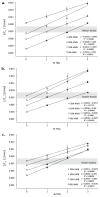Digital micromirror device (DMD)-based 3D printing of poly(propylene fumarate) scaffolds
- PMID: 26838854
- PMCID: PMC4764126
- DOI: 10.1016/j.msec.2015.11.071
Digital micromirror device (DMD)-based 3D printing of poly(propylene fumarate) scaffolds
Abstract
Our recent investigations into the 3D printing of poly(propylene fumarate) (PPF), a linear polyester, using a DMD-based system brought us to a resin that used titanium dioxide (TiO2) as an ultraviolet (UV) filter for controlling cure depth. However, this material hindered the 3D printing process due to undesirable lateral or "dark" curing (i.e., in areas not exposed to light from the DMD chip). Well known from its use in sunscreen, another UV filter, oxybenzone, has previously been used in conjunction with TiO2. In this study we hypothesize that combining these two UV filters will result in a synergistic effect that controls cure depth and avoids dark cure. A resin mixture (i.e., polymer, initiator, UV filters) was identified that worked well. The resin was then further characterized through mechanical testing, cure testing, and cytotoxicity testing to investigate its use as a material for bone tissue engineering scaffolds. Results show that the final resin eliminated dark cure as shown through image analysis. Mechanically the new scaffolds proved to be far weaker than those printed from previous resins, with compressive strengths of 7.8 ± 0.5 MPa vs. 36.5 ± 1.6 MPa, respectively. The new scaffolds showed a 90% reduction in elastic modulus and a 74% increase in max strain. These properties may be useful in tissue engineering applications where resorption is required. Initial cytotoxicity evaluation was negative. As hypothesized, the use of TiO2 and oxybenzone showed synergistic effects in the 3D printing of PPF tissue engineering scaffolds.
Keywords: 3D printing; Bone tissue engineering; Digital micromirror device; Poly(propylene fumarate); Resorbable; UV filter.
Copyright © 2015 Elsevier B.V. All rights reserved.
Figures












Similar articles
-
Optimization of photocrosslinkable resin components and 3D printing process parameters.Acta Biomater. 2019 Oct 1;97:154-161. doi: 10.1016/j.actbio.2019.07.045. Epub 2019 Jul 26. Acta Biomater. 2019. PMID: 31352105
-
Poly(propylene fumarate)-based materials: Synthesis, functionalization, properties, device fabrication and biomedical applications.Biomaterials. 2019 Jul;208:45-71. doi: 10.1016/j.biomaterials.2019.03.038. Epub 2019 Mar 28. Biomaterials. 2019. PMID: 30991217 Review.
-
Extrusion-based 3D printing of poly(propylene fumarate) scaffolds with hydroxyapatite gradients.J Biomater Sci Polym Ed. 2017 Apr;28(6):532-554. doi: 10.1080/09205063.2017.1286184. Epub 2017 Feb 5. J Biomater Sci Polym Ed. 2017. PMID: 28125380 Free PMC article.
-
3D Printing of Poly(propylene fumarate) Oligomers: Evaluation of Resin Viscosity, Printing Characteristics and Mechanical Properties.Biomacromolecules. 2019 Apr 8;20(4):1699-1708. doi: 10.1021/acs.biomac.9b00076. Epub 2019 Mar 12. Biomacromolecules. 2019. PMID: 30807696
-
Photopolymerizable Resins for 3D-Printing Solid-Cured Tissue Engineered Implants.Curr Drug Targets. 2019;20(8):823-838. doi: 10.2174/1389450120666190114122815. Curr Drug Targets. 2019. PMID: 30648506 Review.
Cited by
-
Synthetic Polymers for Organ 3D Printing.Polymers (Basel). 2020 Aug 7;12(8):1765. doi: 10.3390/polym12081765. Polymers (Basel). 2020. PMID: 32784562 Free PMC article. Review.
-
Human gelatin-based composite hydrogels for osteochondral tissue engineering and their adaptation into bioinks for extrusion, inkjet, and digital light processing bioprinting.Biofabrication. 2022 Aug 26;14(4):10.1088/1758-5090/ac8768. doi: 10.1088/1758-5090/ac8768. Biofabrication. 2022. PMID: 35931060 Free PMC article.
-
3D Printing of Bone Substitutes Based on Vat Photopolymerization Processes: A Systematic Review.J Tissue Eng Regen Med. 2023 Apr 8;2023:3901448. doi: 10.1155/2023/3901448. eCollection 2023. J Tissue Eng Regen Med. 2023. PMID: 40226397 Free PMC article.
-
The Optimization of Pressure-Assisted Microsyringe (PAM) 3D Printing Parameters for the Development of Sustainable Starch-Based Patches.Polymers (Basel). 2023 Sep 17;15(18):3792. doi: 10.3390/polym15183792. Polymers (Basel). 2023. PMID: 37765648 Free PMC article.
-
A New Approach to Micromachining: High-Precision and Innovative Additive Manufacturing Solutions Based on Photopolymerization Technology.Materials (Basel). 2020 Jul 1;13(13):2951. doi: 10.3390/ma13132951. Materials (Basel). 2020. PMID: 32630285 Free PMC article. Review.
References
-
- Zonneveld FW, Lobregt S, van der Meulen JC, Vaandrager JM. Three-dimensional imaging in craniofacial surgery. World J Surg. 1989;13(4):328–42. - PubMed
-
- Wallace J, Wang MO, Thompson P, Busso M, Belle V, Mammoser N, Kim K, Fisher JP, Siblani A, Xu Y, Welter JF, Lennon DP, Sun J, Caplan AI, Dean D. Validating continuous digital light processing (cDLP) additive manufacturing accuracy and tissue engineering utility of a dye-initiator package. Biofabrication. 2014;6(1):015003. doi: 10.1088/1758-5082/6/1/015003. - DOI - PubMed
Publication types
MeSH terms
Substances
Grants and funding
LinkOut - more resources
Full Text Sources
Other Literature Sources
Research Materials

